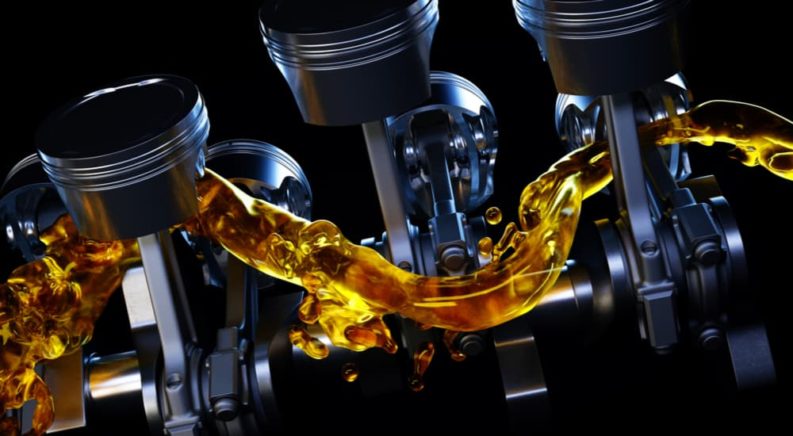Motor oil is one of the most important fluids for any vehicle, but it’s not always very well understood by the average driver. Today’s motor oil is typically broken down in two ways: by viscosity and type. Both are important factors to consider when it comes time for your next Honda oil change, with each blend bringing its own pros and cons. A quick survey of your owner’s manual will turn up the recommended type of motor oil for your specific model and year, but there is a little wiggle room built in that allows drivers some modicum of choice. Unfortunately, it can be all too easy to get lost in the weeds of automotive jargon as you try to figure out which type best suits your specific needs. 5W-30? Synthetic blend? 0W-20? High-mileage? If these terms seem confusing, you’ve come to the right place. Follow along as we outline the major differences between different types of motor oil and see which formulation is right for your Honda.
Motor Oil Viscosities
Viscosity, also known as the “weight” of a motor oil, basically determines how thick the oil is and, therefore, how easily it’ll flow through vital engine components. Motor oil viscosity is usually expressed as something like 5W-30, but what do those numbers actually mean? Well, starting out from left to right, the “5” in 5W-30 represents the rate at which the oil will flow at a temperature of 0 degrees Fahrenheit (or around -18 degrees Celsius). A lower viscosity means that the oil will not thicken as much when the temperature starts to drop, which can be an important consideration for drivers in colder climates or those who face harsh winters. A rating of 5 is pretty much the middle of the pack, with a 0-weight oil flowing easier in low temps while a 10-weight oil would flow less easily.
The W in the oil’s viscosity rating stands for “Winter” and refers to its suitability for winter temperatures, while the number after the W describes the motor oil’s ability to resist thinning at higher temps (212 Fahrenheit or 100 degrees Celsius). Much like the low-temperature rating found before the W, a lower number at the end of your oil’s viscosity rating means it’ll flow a little easier than a higher number would. For example, a 5W-30 will thin out more quickly when exposed to higher temps than a 5W-40 would.
So what does this mean for the average driver? For those living in more temperate areas without a drastic temperature change between the summer and winter seasons, the answer is not much. These drivers might be able to roll with the same weight of motor oil year-round, making oil changes and maintenance pretty routine. The same isn’t true for those of us in chillier climates where low winter temperatures can cause heavier motor oil to thicken into more of a sludge that has little benefit for your engine.
There are a number of benefits to using temperature-appropriate motor oil, especially when it comes to colder climates. A thinner motor oil will make for easier starts, especially on colder mornings. It will also promote fuel efficiency, giving you more miles per gallon and more money in your pocket. When it comes to Hondas, the manufacturer generally recommends using a standard 5W-20 motor oil on vehicles produced between 2001 and 2010 and a 0W-20 for those produced from 2011 to the present. There are some exceptions to this rule, like the Civic Hybrid and Insight, which both require a 0W-20, so consult your owner’s manual for specific recommendations.
Both 5W-20 and 0W-20 provide solid tear-round protection for drivers in most circumstances, but those on either end of the temperature spectrum might want to opt for a thinner or thicker blend depending on where they live. Drivers in particularly hot regions might want to go with a thicker 10W-30 product, though such oils might become too thick if the thermometer drops below 20 degrees Fahrenheit. It’s also important to use high-quality motor oil and stick to a rigid schedule, as some of the cheaper options tend to thicken up over time. That 5W-20 you used can turn into something more like a 5W-40 if it exceeds its service life, so don’t skimp when it comes time to change the oil.

Motor Oil Types
Now that we’ve covered the different viscosities let’s move on to the four major types of motor oil. Roughly speaking, motor oil can be categorized as either conventional or synthetic, with each type offering its own advantages and disadvantages when it comes to cost and performance.
Convention Oil
Conventional motor oil is the tried-and-true option for drivers on a budget but often doesn’t offer the same protection as newer full-synthetic or synthetic blend oils. Sure, it’s the cheapest option of the four, but it doesn’t do much more than what it says on the package. Conventional motor oil is a good choice for drivers with low-mileage engines and those who are good about keeping to a regular oil change schedule, but it can be a bit of a hassle when compared to some of the more modern, higher-tech options out there today. Conventional motor oil also needs to be changed around every 3,000 miles, making it one of the shortest-lasting of the bunch. There is also some premium conventional motor oil out there on the market, which offer more in the way of performance, but also come at a higher price.
Full-Synthetic Oil
Full-synthetic oil brings all the marvels of modern automotive engineering to your vehicle. Full-synthetic oil has been thoroughly scrubbed of any impurities that can cause long-term damage and are packed with additives that go a long way in cleaning out your engine and keeping it purring along for miles to come. It’s an all-around better oil for almost any application, but that improved performance comes at a cost. Full-synthetic oil is more expensive than conventional options, sometimes costing up to three times as much. This might sound like a dealbreaker, but when you consider the fact that it needs to be changed far less often than conventional motor oil (every 7,500 to 12,000 miles, according to some estimates), it might actually be the cheaper option in the long run. Bonus: Full-synthetic oil, and synthetics in general, offer lower viscosity than their conventional forerunners meaning your engine will not be as susceptible to the type of temperature fluctuations that can make for a rough start or low fuel efficiency.
Synthetic Blend Oil
Synthetic blend oil is just what it sounds like: a blend of premium conventional oil with a dash of synthetic oil added to the mix. Synthetic blends split the difference between the two more popular types, giving drivers the performance of a full-synthetic at a price point that’s a little closer to most premium conventional motor oils. Synthetic blends are particularly popular among pickup truck and SUV drivers who appreciate the oil’s ability to perform in a variety of temperatures, especially when dealing with a heavy, fully-loaded vehicle.
High-Mileage Oil
Designed for older vehicles that have seen more than 75,000 tick by on the odometer, high-mileage motor oil is formulated with a number of engine-scrubbing cleaners, as well as seal conditioners that breathe new life into old, worn-out engine seals. This reduces oil leakage and burn-off, a common problem with older vehicles, and is perfect for any engines that are starting to show their age. It’s not the cheapest option of the four listed here, but the price is pretty reasonable when compared to the cost of rebuilding or replacing an engine.

Consider Your Oil Choice Carefully
As you can see, all motor oil is not created equal. While the choice to go with a full-synthetic or a synthetic blend over a conventional motor oil largely comes down to a matter of preference and budget, there are some key takeaways every driver should keep in mind next time they pull into a service station for their next oil change. Full-synthetic and synthetic blend motor oils might be more expensive, but they carry a number of advantages that can actually make them a better value than some lower-cost options.
Lower viscosity motor oil enables quicker fuel combustion, translating to improved MPG and less money spent at the pump. Given their low viscosity when compared to conventional motor oil, synthetic options are also easier on the engine in general, flowing more easily and making for easier starts. They’re also better able to protect the engine, with their low viscosity enabling them to flow into every nook and cranny to prevent potentially damaging metal-on-metal contact within the engine. This is especially important in low temperatures. Thicker motor oil can take as long as three minutes to spread into every corner of the engine, while lower-viscosity options will reach vital components in as little as 10 seconds. Yes, full-synthetic, synthetic blend, and high-mileage motor oils might be more expensive options, but given the frequency with which they need to be replaced when compared with conventional motor oil, they’re a relative bargain.
Honda recommends using the same Honda Genuine Synthetic Motor Oil that your vehicle came with when it first rolled off the factory floor. Available at your local Honda dealer, this concoction is specifically formulated for use in Honda engines, providing a number of benefits you won’t find in your everyday, off-the-shelf products. Honda Genuine Synthetic Motor Oil helps combat the formation of sludge and varnish, resists foaming, protects against rust and bearing corrosion, and is excellent when it comes to preventing thermal breakdown. It can also have a noticeable effect on emissions, lessening the load on your catalytic converter and reducing the pollutants in your exhaust. If Honda Genuine Synthetic Motor Oil isn’t available, the automaker recommends using a premium-grade conventional motor oil or ultimate full-synthetic in its place.

